49 Location Based Inventory
This chapter covers the following topics:
Item Movement
The store assigns and adds received items to a specific inventory location. Then, when the item is removed from the initial inventory location, it...
-
is transferred to another inventory location, or
-
leaves the store as the result of a sale transaction, or
-
is shipped out as an inventory transaction, or
-
is adjusted as part of an inventory adjustment transaction.
These item movements are tracked through Location IDs and Bucket IDs that are used to track the physical location and the current status of each item in inventory.
Locations and Buckets
This section uses the terms Location ID and Bucket ID frequently. As used in this document, a Location ID generally refers to a physical location where items are found such as a warehouse, or back room, or shelf, and it includes specific inventory buckets that are associated with it.
A bucket is a descriptive term that usually relates to the status of an item in a particular location. For example, the On Hand bucket is a very inclusive category relating to currently available items. Layaway is a different bucket that relates only to items that are included in a layaway account but may (or may not) be in the same Location ID as on- hand items.
Depending on your system setup, items with one Location ID may not need to belong to a specific Bucket ID, and items with a specific Bucket ID do not need to belong to a specific Location ID. For example, the Warehouse location could contain items that are assigned to the Repair, Special Order, and Layaway buckets. Meanwhile, the Special Order bucket could contain items in the Warehouse and On Order locations.
Some inventory locations are configured at the corporate level, though additional inventory locations can be added and configured at the store level. Inventory buckets are configured solely at the corporate level.
Location Based Inventory Menu
The Location Based Inventory Menu offers selections that allow you to perform various operations related to inventory locations and the items that are located there:
-
Inventory Location Maintenance: Existing inventory locations may be maintained (viewed, edited, and deleted). See Inventory Location Maintenance. You also have the option to create a new inventory location. See Define a New Inventory Location.
-
Movement Pending Reconciliation: Use this option to reconcile inventory changes stored in a temporary location with the actual inventory. See Movement Pending Reconciliation.
-
Inventory Movement Pending Report: The Inventory Movement Pending Report shows items from transactions in which an inventory location has not yet been specified when Location Based Inventory is being used. This report shows the transaction number, transaction date, item ID and quantity, and the inventory action code that is currently assigned. Refer to the Oracle Retail Xstore Point of Service Reports Guide for information about this report, as well as the Inventory Movement Report, Inventory Movement History Report, and Item List Report.
Figure 49-1 Location Based Inventory Menu

Inventory Location Maintenance
Inventory Location Maintenance allows you to edit the parameters of an inventory location or add/delete store-specific inventory locations for the local store. When editing an inventory location, Inventory Location Maintenance allows you to search for a specific inventory location by Location ID, location description, or associated bucket (for example, Special Order, Damaged, Order, and so on).
Note:
Inventory Location Maintenance does not allow you to move items. Moving items within an inventory location must be performed within the Item Transfer function. See Item Transfer.
-
At the Location Based Inventory Menu, select the Inventory Location Maintenance option.
The system displays the Inventory Location Search form.
Figure 49-2 Inventory Location Search Form
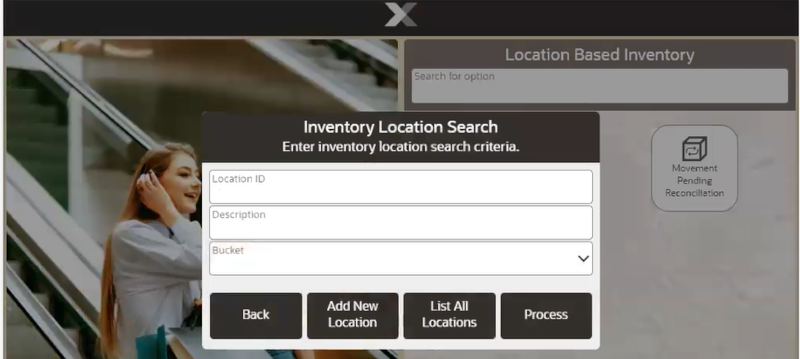
-
Search options:
-
If you know a Location ID, enter it in the Location ID field and select Process. The system lists the matching Location IDs, and you may select the one you want. Continue with step 3.
-
If you do not know the ID of the location you want to see, select List All Locations. The system displays all the existing Location IDs. Select the one you want and choose OK. Continue with step 3.
-
To search by the Bucket, select one or more buckets from the list and then select Process.
-
If you want to create a new inventory location, select Add New Location. See Define a New Inventory Location.
-
-
Maintain the location as needed at the Inventory Location Maintenance form.
Figure 49-3 Inventory Location Maintenance Form
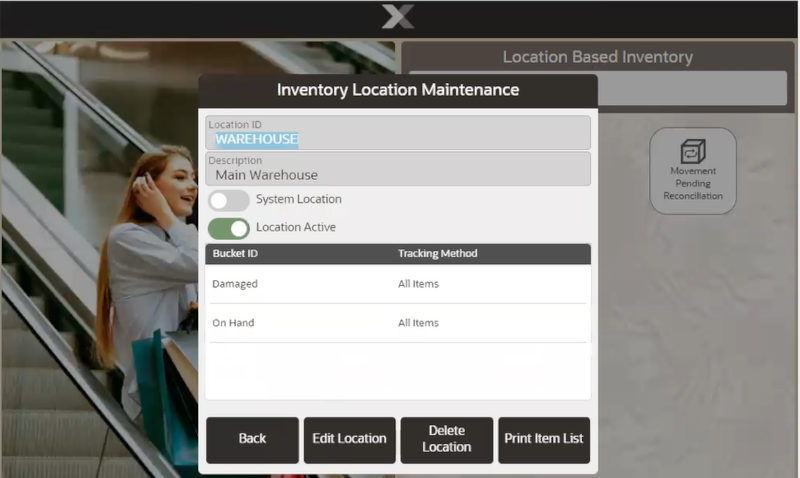
Select one of these options:
-
Back: This returns you to the Inventory Location Search form.
-
Edit Location: Select this option to make changes to the location. The Location ID cannot be changed.
-
Description: Edit the description as needed.
-
Location Active: Enabled indicates the location is currently being used and grayed out means the location is inactive and cannot be counted unless its status is enabled.
For each Bucket ID, indicate the tracking method used by selecting an option from the drop-down list in the Tracking Method field.
After making your changes, select the Save Changes option to update the location.
-
-
Delete Location: Select this option if you decide to remove the location. You are prompted to confirm the deletion. Select Yes to proceed or No to continue without deleting the location.
-
Print Item List: Select this option to print a list showing all items in the location.
-
Define a New Inventory Location
This feature allows you to specify a new inventory location within your store.
-
At the Location Based Inventory menu, select the Inventory Location Maintenance option.
The system displays the Inventory Location Search form (Figure 49-2).
-
Select Add New Location. The system displays a form where you can define a new inventory location for your store:
Figure 49-4 Defining a New Inventory Location
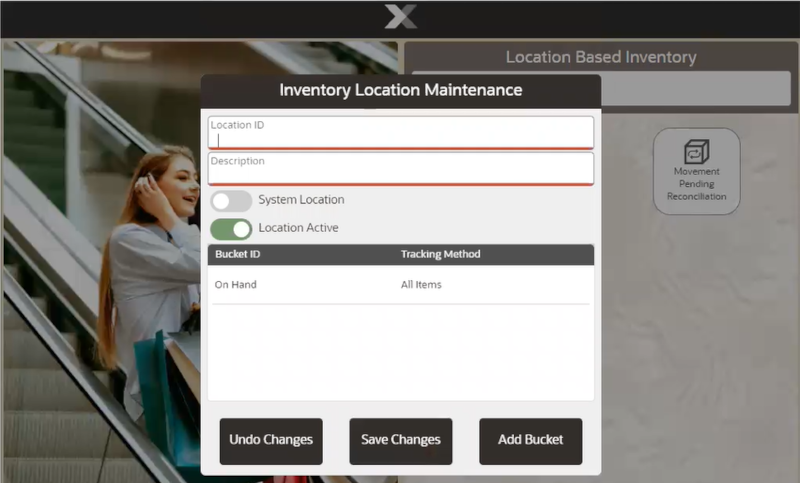
-
In the Location ID field, enter the name you are assigning to the new location. Once this is saved, it cannot be changed but the location can be deleted.
-
In the Description field, enter a brief text description for the new location.
-
The System Location field is defined and set up by the Home Office and cannot be changed or deleted. Home-office defined locations show an Enabled status in this field.
-
Select the Location Active status by sliding the toggle switch. Green indicates the location is currently being used and gray means the location is inactive and cannot be counted unless its status is enabled.
-
-
Select Add Bucket and select a bucket to use at this location.
Note:
You cannot define new buckets. All buckets are defined by and downloaded from the Home Office.
You must decide what tracking method is used for each bucket that you include in the new Location ID. Select whether all items are tracked, or just serialized items only are tracked, from the drop-down list in the Tracking Method field for each bucket that you assign to the location.
Repeat for each bucket at this location.
-
After you have determined which buckets are included and you have assigned their respective tracking methods, select Save Changes to create the new location. The system displays a read-only view of the selections for the new Location ID.
Figure 49-5 Read-Only View of New Location ID
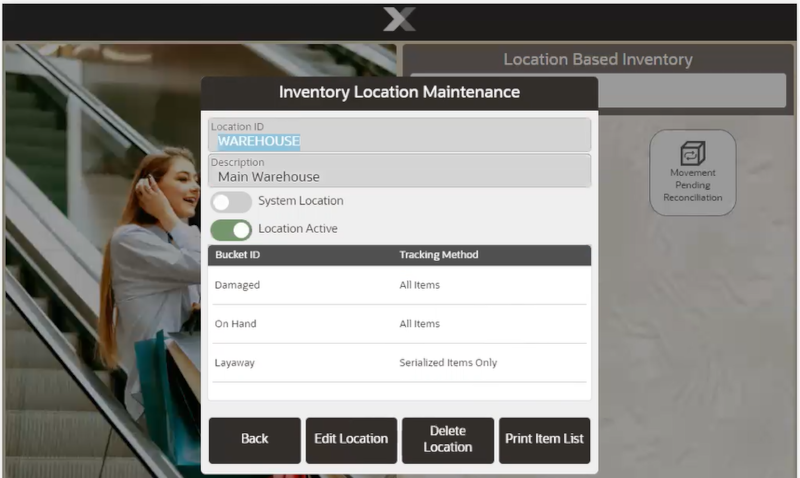
Select one of these options:
-
Back: This returns you to the Inventory Location Search form.
-
Edit Location: Select this option to make changes to the new location. You cannot change the Location ID.
-
Delete Location: Select this option if you decide to remove the location. You are prompted to confirm the deletion. Select Yes to proceed or No to continue without deleting the location.
-
Print Item List: Select this option to print a list with all items in the location, according to the Bucket IDs that you assigned to that location.
Note:
To edit items within an inventory location, use the Item Transfer function. See Item Transfer.
-
Movement Pending Reconciliation
The Movement Pending inventory location is a default, virtual location for any items for which an inventory location was not specified at the time of a sale, layaway setup, or inventory shipment. This inventory location is a temporary location and items in this inventory location must be reconciled.
To reconcile items in this virtual inventory location, the sold item must first be transferred from the Movement Pending inventory location to a defined merchandise inventory location/bucket. Next, the item must be removed from the merchandise inventory location/bucket, and transferred to either the SOLD bucket, LAYAWAY bucket, or SHIPPED bucket (based on the transaction type).
An item appears on the Movement Pending Reconciliation list if the following criteria are met:
-
Your system is set up to track inventory movements that are pending.
-
Your system does not prompt for a Location ID during a transaction (sales transactions and shipping transactions).
-
An item is found in more than one Location ID or is not assigned to any Location ID in your store.
-
An item is assigned to a specific Bucket ID within the Location ID where it is found. For example, for sales, shipping, and layaway setup transactions, the item must be in the ON_HAND bucket.
Figure 49-6 Location Based Inventory Menu Options

-
Select Movement Pending Reconciliation from the Location Based Inventory Menu.
The system displays a screen where you can select pending items and reconcile them, that is move them to a defined inventory location.
Figure 49-7 Movement Pending Reconciliation Screen
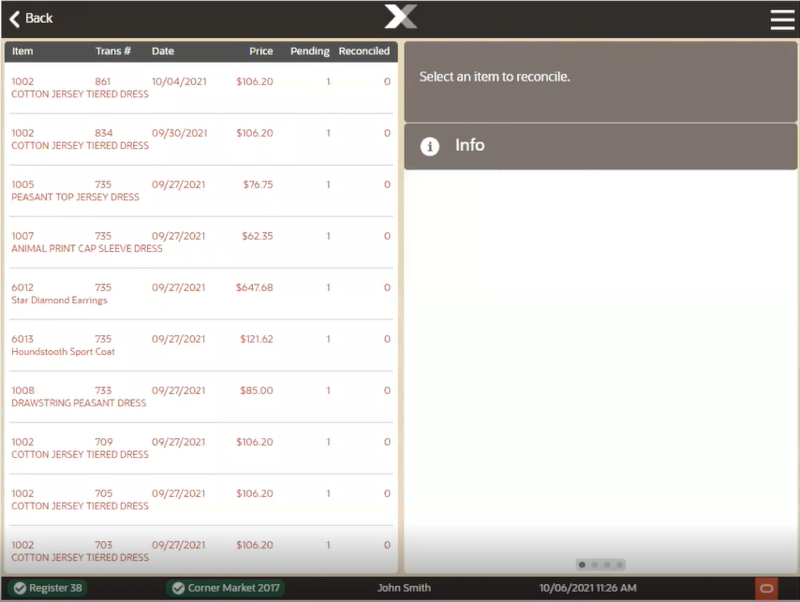
If you would like to have a printed report of the items pending reconciliation, select the Print Movement Pending option.
Figure 49-8 Print Movement Pending Option

-
Select the item on the list that you want to reconcile.
Figure 49-9 Movement Pending Item Menu
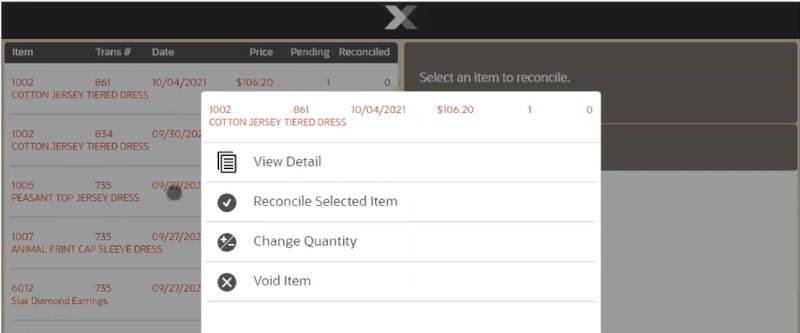
-
If needed, select one of the following menu options:
-
View Detail: Displays the details of the transaction, which store, register, date and time, and details of the item.
Figure 49-10 Details of an Item Pending Reconciliation
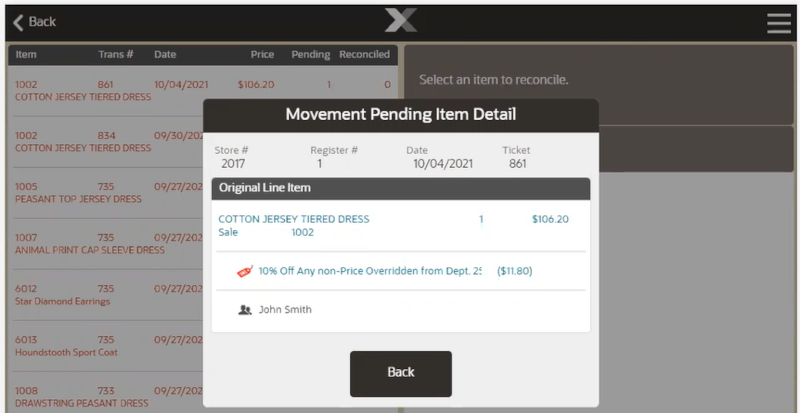
-
Change Quantity: You are prompted to select the item and then enter the quantity that you want to reconcile for the item.
-
Void Item: This removes the item from the list.
-
-
Select Reconcile Selected Item.
-
The system prompts for the item's source inventory location. Select a location from the drop- down list and select Process.
Figure 49-11 Select Source Location for Item Being Reconciled
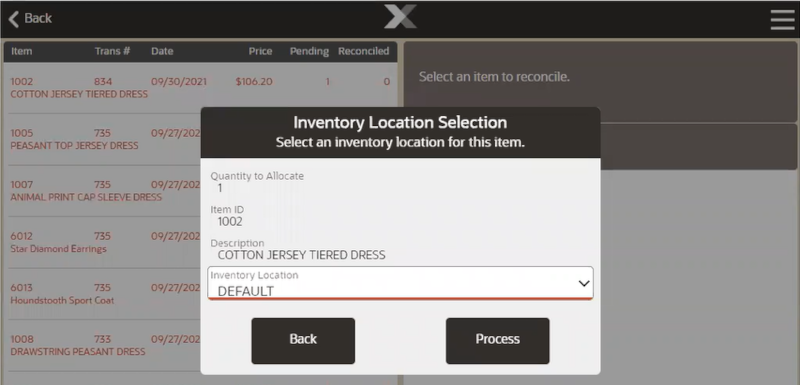
-
The system prompts for the item quantity. Enter the number of items being moved from the location you selected and press OK.
Figure 49-12 Prompt for Quantity to be Reconciled
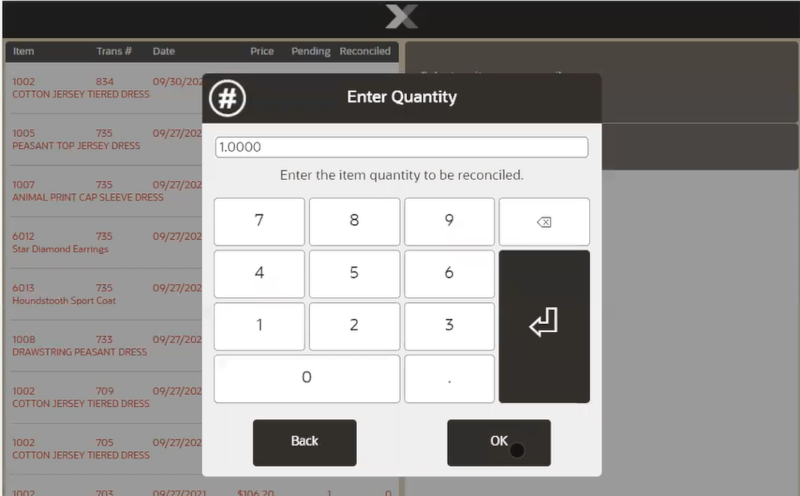
The system returns to the list of items that are awaiting reconciliation. The item that you just reconciled is highlighted in green, and the Reconciled column now displays the quantity that you entered for the item.
Repeat steps 4 to 6 for each item.
Figure 49-13 Items Reconciled

-
Select the Save & Exit option to retain the reconciliation(s) that you just completed.
-
You are prompted to confirm that you want to save your changes.
Figure 49-14 Save Changes Prompt

Choose Yes to save the information, or No to return to the list of reconcilable items. If you choose Yes, the item is removed from the list of items awaiting reconciliation.
The system automatically prints the Inventory Movement Report and includes all the items that were just reconciled and saved.
After printing the report, the system returns to the Location Based Inventory menu.